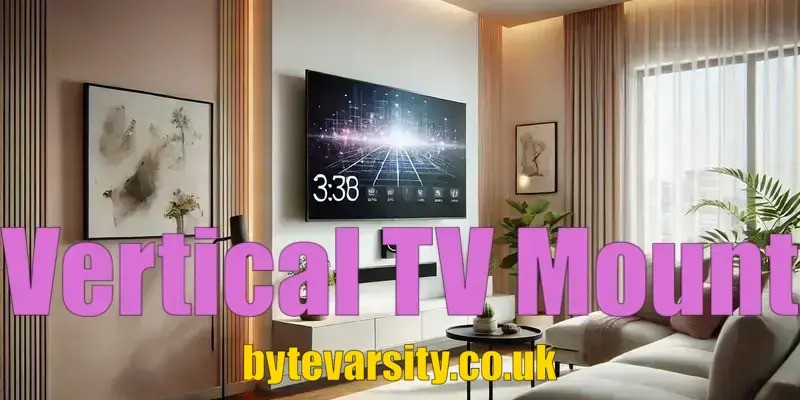Introduction to Vertical TV Mounts
Vertical TV mounts are a fantastic solution for maximizing space and adding style, especially in compact rooms. These mounts secure your TV in a portrait orientation rather than the standard landscape, giving you a unique look that’s increasingly popular in modern, minimalist spaces. But what exactly is a vertical TV mount, and is it the right choice for you? Let’s dig in.
Related: TV Mounts
What Is a Vertical TV Mount?
A vertical TV mount, as the name suggests, allows a TV to be mounted in a vertical or portrait orientation on the wall. Unlike traditional horizontal mounts, these are designed to hold the TV securely in a tall, narrow position.
For some, a vertical TV setup is purely aesthetic, offering a sleek and unconventional look. However, for others, it’s all about functionality. Maybe you have limited wall space, or you want to display portrait-mode content such as photos, videos, or digital signage. Vertical mounts come in a variety of styles and sizes, from fixed mounts to those with pivoting and tilting capabilities, so you can find one that meets your needs perfectly.
Who Should Consider a Vertical TV Mount?
A vertical TV mount might sound niche, but it’s ideal for various users:
- Small Space Dwellers: If you’re working with a compact room or narrow wall, a vertical mount can help you save precious inches without sacrificing screen size.
- Digital Art Enthusiasts: A vertical mount allows you to showcase artwork, photos, or digital installations, almost like a picture frame.
- Professional Settings: Offices, salons, and stores often use vertical mounts to display signage, schedules, and promotional content in a clean, visible way.
In short, anyone looking to combine functionality with a distinctive look will likely appreciate the versatility of a vertical mount.
Benefits of Using a Vertical TV Mount
Vertical TV mounts have plenty of perks that go beyond just saving space. Here’s why people are increasingly turning to them.
Space-Saving Solution for Small Rooms
One of the biggest selling points is how these mounts help save space. Especially if you have a slim wall or limited floor area, going vertical can be a game-changer. Unlike bulky entertainment centers or media consoles, a vertical mount hugs the wall, making a room feel less cluttered and more open. For small apartments, studios, or tight corners, this is an invaluable advantage.
Enhanced Viewing for Portrait-Mode Content
If you’re big on photography, design, or social media, a vertical mount allows you to view and share portrait-mode content in its intended orientation. No more turning your head to the side! It’s also ideal for people who love using their TV as a digital canvas to display art, photography, or other creative media.
Types of Vertical TV Mounts
Just like with horizontal mounts, there are several types of vertical mounts to suit your style and functionality needs.
Fixed Vertical Mounts
A fixed vertical mount is the simplest and often the most affordable option. It secures the TV tightly to the wall in a fixed position, which is perfect if you don’t need to adjust the screen angle. This is ideal for anyone who mainly wants to use their TV as a stylish piece of decor or display.
Rotating and Pivot Mounts
For those who want flexibility, rotating or pivoting vertical mounts are the way to go. These mounts allow you to tilt, swivel, or even rotate the TV between portrait and landscape modes, giving you more control over your viewing experience. While they’re usually pricier, rotating mounts add convenience for users who need to adjust the screen for multiple purposes or different viewing angles.
How to Install a Vertical TV Mount
Installing a vertical TV mount isn’t all that different from a traditional one, but there are a few unique considerations.
Tools and Preparation
Before you begin, make sure you have the necessary tools on hand:
- A drill and drill bits
- A level to ensure a straight installation
- The mount’s specific hardware (included in most mount kits)
- A stud finder, if mounting on drywall
Ensure the wall is strong enough to support the TV’s weight, and always locate a wall stud for stability.
Steps for Secure Installation
- Find the Right Spot: Mark the area where you want to install the mount. It’s essential to keep the height and viewing angles in mind, as a vertical screen can sometimes require adjustments.
- Attach the Mount to the Wall: Use the provided hardware and follow the mount’s instructions carefully. Once it’s securely fastened, double-check with a level.
- Mount the TV: Once the bracket is attached to the wall, you’re ready to lift and secure the TV. It may require an extra set of hands to help align the TV with the wall mount, ensuring a safe and steady installation.
Frequently Asked Questions About Vertical TV Mounts
Many first-timers have questions about using a vertical TV mount. Let’s clear up some of the most common ones.

Can Any TV Be Mounted Vertically?
Most modern flat-screen TVs can be mounted vertically, but it’s always a good idea to check the manufacturer’s guidelines. Some screens may have optimal viewing angles or backlight designs that don’t work as well in a vertical orientation. If you’re unsure, consult the manual or contact the manufacturer.
What’s the Ideal Height for a Vertical TV Mount?
The ideal height for a vertical mount largely depends on your room and viewing preferences. A common rule of thumb is to mount the center of the TV at eye level when sitting down. For portrait-mode displays, you might want it slightly higher, especially if it’s being used for signage or as an art piece.
Final Thoughts
A vertical TV mount is a unique way to transform your space, making it stylish and functional without taking up much room. From displaying art to enhancing small spaces, it’s a versatile choice for any home or professional setting.